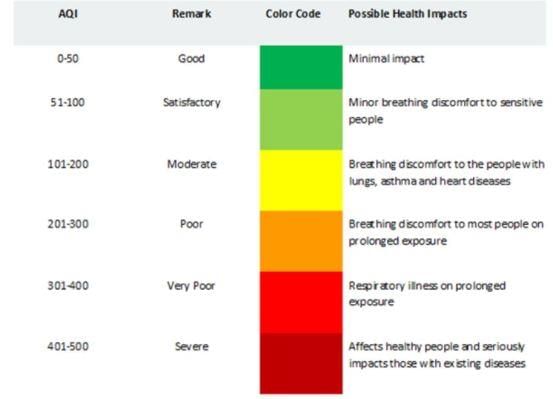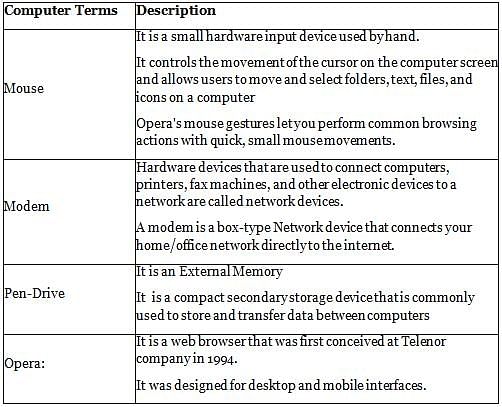APSET Paper 1 Mock Test - 1 - AP TET MCQ
30 Questions MCQ Test APSET Mock Test Series 2025 - APSET Paper 1 Mock Test - 1
Research has shown that the most frequent symptom of nervous instability among teachers is
Directions: Read the following passage carefully and answer the question.
The Taj Mahal has become one of the world’s best known monuments. This domed white marble structure is situated on a high plinth at the southern end of a four-quartered garden, evoking the gardens of paradise, enclosed within walls measuring 305 metres by 549 metres. Outside the walls, in an area known as Mumtazabad, were living quarters for attendants, markets, sarais and other structures built by local merchants and nobles. The tomb complex and the other imperial structures of Mumtazabad were maintained by the income of thirty villages given specifically for the tomb’s support. The name Taj Mahal is unknown in Mughal chronicles, but it is used by contemporary Europeans in India, suggesting that this was the tomb’s popular name. In contemporary texts, it is generally called simply the Illuminated Tomb (Rauza-i-Munavvara).
Mumtaz Mahal died shortly after delivering her fourteenth child in 1631. The Mughal court was then residing in Burhanpur. Her remains were temporarily buried by the grief-stricken emperor in a spacious garden known as Zainabad on the bank of the river Tapti. Six months later, her body was transported to Agra, where it was interred in land chosen for the mausoleum. This land, situated south of the Mughal city on the bank of the Jamuna, had belonged to the Kachhwaha rajas since the time of Raja Man Singh and was purchased from the then current raja, Jai Singh. Although contemporary chronicles indicate Jai Singh’s willing cooperation in this exchange, extant farmans (imperial commands) indicate that the final price was not settled until almost two years after the mausoleum’s commencement. Jai Singh’s further cooperation was insured by imperial orders issued between 1632 and 1637 demanding that he provide stone masons and carts to transport marble from the mines at Makrana, within his “ancestral domain”, to Agra where both the Taj Mahal and Shah Jahan’s additions to the Agra fort were constructed concurrently.
Work on the mausoleum was commenced early in 1632. Inscriptional evidence indicates much of the tomb was completed by 1636. By 1643, when Shah Jahan most lavishly celebrated the ‘Urs ceremony for Mumtaz Mahal’, the entire complex was virtually complete.
Q. The popular name Taj Mahal was given by
The Taj Mahal has become one of the world’s best known monuments. This domed white marble structure is situated on a high plinth at the southern end of a four-quartered garden, evoking the gardens of paradise, enclosed within walls measuring 305 metres by 549 metres. Outside the walls, in an area known as Mumtazabad, were living quarters for attendants, markets, sarais and other structures built by local merchants and nobles. The tomb complex and the other imperial structures of Mumtazabad were maintained by the income of thirty villages given specifically for the tomb’s support. The name Taj Mahal is unknown in Mughal chronicles, but it is used by contemporary Europeans in India, suggesting that this was the tomb’s popular name. In contemporary texts, it is generally called simply the Illuminated Tomb (Rauza-i-Munavvara).
Mumtaz Mahal died shortly after delivering her fourteenth child in 1631. The Mughal court was then residing in Burhanpur. Her remains were temporarily buried by the grief-stricken emperor in a spacious garden known as Zainabad on the bank of the river Tapti. Six months later, her body was transported to Agra, where it was interred in land chosen for the mausoleum. This land, situated south of the Mughal city on the bank of the Jamuna, had belonged to the Kachhwaha rajas since the time of Raja Man Singh and was purchased from the then current raja, Jai Singh. Although contemporary chronicles indicate Jai Singh’s willing cooperation in this exchange, extant farmans (imperial commands) indicate that the final price was not settled until almost two years after the mausoleum’s commencement. Jai Singh’s further cooperation was insured by imperial orders issued between 1632 and 1637 demanding that he provide stone masons and carts to transport marble from the mines at Makrana, within his “ancestral domain”, to Agra where both the Taj Mahal and Shah Jahan’s additions to the Agra fort were constructed concurrently.
Work on the mausoleum was commenced early in 1632. Inscriptional evidence indicates much of the tomb was completed by 1636. By 1643, when Shah Jahan most lavishly celebrated the ‘Urs ceremony for Mumtaz Mahal’, the entire complex was virtually complete.
Direction: Following table shows the percentage distribution of votes amongst five candidates A, B, C, D and E and total votes cast (in hundred) during the year 2013 to 2018 of collage presidential election. Study the data carefully and answer the questions based on it.
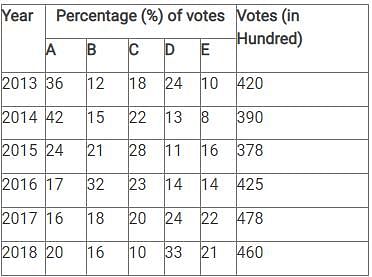
Q. What is the average number of votes a candidate gets in 2018?

A computer program that translates a program statement by statement into machine language is called a/an
Directions: Read the following passage carefully and answer the given question.
James adison said, "People who mean to be their own governors must arm themselves with power that knowledge gives." In India, the Official Secrets Act, 1923 was a convenient smokescreen to deny members of the public access to information. Public functioning has traditionally been shrouded in secrecy. But in a democracy in which people govern themselves, it is necessary to have more openness. In the maturing of our democracy, right to information is a major step forward; it enables citizens to participate fully in the decision-making process that affects their lives so profoundly. It is in this context that the address of the Prime Minister in the Lok Sabha is significant. He said, "I would only like to see that everyone, particularly our civil servants, should see the Bill in a positive spirit; not as a draconian law for paralysing Government, but as an instrument for improving Government-Citizen interface resulting in a friendly, caring and effective Government functioning for the good of our People." He further said, "This is an innovative Bill, where there will be scope to review its functioning as we gain experience. Therefore, this is a piece of legislation, whose working will be kept under constant reviews."
The Commission, in its Report, has dealt with the application of the Right to Information in Executive, Legislature and Judiciary. The Judiciary could be a pioneer in implementing the Act in letter and spirit because much of the work that the Judiciary does is open to public scrutiny. Government of India has sanctioned an e-governance project in the Judiciary for about Rs. 700 crore which would bring about systematic classification, standardisation and categorisation of records. This would help the Judiciary to fulfil its mandate under the Act. Similar capacity building would be required in all other public authorities. The transformation from non-transparency to transparency and public accountability is the responsibility of all three organs of the State.
Q. Right to Information is a major step forward to
The UGC has mandated a six‐month module syllabus for UG courses for all branches of higher education with the objective:
A. to implement CBCS in the true sense
B. to enhance knowledge, skills and attitude towards the environment
C. to provide first‐hand knowledge on various local environmental aspects
D. to implement the order of Hon'ble Supreme Court of India
E. to protect the environment
Choose the correct answer from the options given below:
Directions: Read the following passage and answer the given questions:
Recently, India witnessed a severe power shortage due to high demand and the non-availability of adequate coal supply. An energy deficit of more than 100 million units has been recorded during the month of April 2022. Rajasthan, Haryana, Punjab, UP, Bihar, and Madhya Pradesh were the most affected states. India is the second largest country in terms of population, and the usage of electricity is increasing day by day. In today's India, electricity has reached even the remotest areas, and people are reaping its benefits. Electricity is critical to the overall development of society and the country, including technological development. However, technological advances require more electricity. The power requirement of many industries, such as railroads, agriculture, and domestic use, is increasing day by day.
The advancement of technology and the resurgence of economic activity following the COVID-19 disruptions increased the demand for power. In April 2022, the average daily energy requirement increased to 4,512 million units, as opposed to 3,941 million units in April 2021, registering a growth of 14.5%. The use of electricity has increased in many industries, including railways, agriculture, and households. India's thermal power plants are also running well below their capacity, which could have managed this demand increase by increasing thermal generation. To address the problem of the power crisis in India, there is a need to change our planning and policies from ones that mainly manage shortages to ones that are flexible. Policies should be formulated with a focus on long-term structural solutions that address delivery, financial viability, and a robust mechanism for resource planning. The focus should be on ensuring that power plants operate efficiently. To address power shortages, a strategic approach to the low-cost energy transition, such as renewable energy and opportunities for diversification in the energy mix, is critical. For long-term power security, greater attention should be paid to accelerating generation from renewable energy sources.
Q. What are the causes of India's severe electricity shortage?
Match List I with List II

Choose the correct answer from the options given below:
Direction: Read the passage carefully and choose the best answer to each question out of the four alternatives.
It is not good manners to stop a person on the street or in a shop, or in the performance of any duty and to talk to him for ten, fifteen, or twenty minutes just to pass the time of day. We can tell that a person is in a hurry to get somewhere, or he is doing something, and we know enough not to interrupt him for any length of time. Yet some of us think nothing of calling someone on the telephone, interrupting him without a thought about what he may be doing, and chattering away, forgetting about time or anything else. Perhaps we don’t consider our telephone conversation an interruption because we don’t see what we have interrupted. Naturally, we must observe the common courtesies over the telephone. But we must remember that one of the courtesies of telephoning is to be brief.
Never ask anybody to guess who you are? The person you are telephoning may not be in a guessing mood. If you know him, you may want to ask after the state of his health and that of his family, but as soon as you possibly can, go get on with your business. He certainly wants to know why you are telephoning him. When you are finished with your business, you might take moment to observe the natural courtesies of conversation, expressing your thanks before ending your call.
From the way the telephone is used in your home, you would hardly suspect that this is an instrument on which very important business transactions are conducted. There are times when even you are called upon to be business-like, brief, and effective on the telephone.
Q. How can we make the best use of a telephone?
In which of the following Ancient Indian universities, the culture and civilization of Tibet was built mainly through the writings of the scholars?
Manuel Castelle was the first to use which of the following terms?
Directions: Read the following passage carefully and answer the question.
The popular view of towns and cities in developing countries and of urbanisation process is that despite the benefits and comforts it brings, the emergence of such cities connotes environmental degradation, generation of slums and squatters, urban poverty, unemployment, crimes, lawlessness, traffic chaos etc. But what is the reality? Given the unprecedented increase in urban population over the last 50 years from 300 million in 1950 to 2 billion in 2000 in developing countries, the wonder really is how well the world has coped, and not how badly.
In general, the urban quality of life has improved in terms of availability of water and sanitation, power, health and education, communication and transport. By way of illustration, a large number of urban residents have been provided with improved water in urban areas in Asia’s largest countries such as China, India, Indonesia and Philippines. Despite that, the access to improved water in terms of percentage of total urban population seems to have declined during the last decade of 20th century, though in absolute numbers, millions of additional urbanites have been provided improved services. These countries have made significant progress in the provision of sanitation services too, together, providing for an additional population of more than 293 million citizens within a decade (1990-2000). These improvements must be viewed against the backdrop of rapidly increasing urban population, fiscal crunch and strained human resources and efficient and quality-oriented public management.
Q. Which of the following statements cannot be inferred from the given passage?
Which one of the following is considered a sign of motivated teaching?
Which of the following is/are classified in the category of the developmental research?
Directions: Read the following passage carefully and answer the question.
It should be remembered that the nationalist movement in India, like all nationalist movements, was essentially a bourgeois movement. It represented the natural historical stage of development, and to consider it or to criticise it as a working-class movement is wrong. Gandhi represented that movement and the Indian masses in relation to that movement to a supreme degree, and he became the voice of Indian people to that extent. The main contribution of Gandhi to India and the Indian masses has been through the powerful movements which he launched through the National Congress. Through nation-wide action he sought to mould the millions, and largely succeeded in doing so, and changing them from a demoralised, timid and hopeless mass, bullied and crushed by every dominant interest, and incapable of resistance, into a people with self-respect and self-reliance, resisting tyranny, and capable of united action and sacrifice for a larger cause.
Gandhi made people think of political and economic issues and every village and every bazaar hummed with argument and debate on the new ideas and hopes that filled the people. That was an amazing psychological change. The time was ripe for it, of course, and circumstances and world conditions worked for this change. But a great leader is necessary to take advantage of circumstances and conditions. Gandhi was that leader, and he released many of the bonds that imprisoned and disabled our minds, and none of us who experienced it can ever forget that great feeling of release and exhilaration that came over the Indian people.
Gandhi has played a revolutionary role in India of the greatest importance because he knew how to make the most of the objective conditions and could reach the heart of the masses, while groups with a more advanced ideology functioned largely in the air because they did not fit in with those conditions and could therefore not evoke any substantial response from the masses.
It is perfectly true that Gandhi, functioning in the nationalist plane, does not think in terms of the conflict of classes, and tries to compose their differences. But the action he has indulged and taught the people has inevitably raised mass consciousness tremendously and made social issues vital. Gandhi and the Congress must be judged by the policies they pursue and the action they indulge in. But behind this, personality counts and colours those policies and activities. In the case of very exceptional person like Gandhi, the question of personality becomes especially important in order to understand and appraise him. To us he has represented the spirit and honour of India, the yearning of her sorrowing millions to be rid of their innumerable burdens, and an insult to him by the British Government or others has been an insult to India and her people.
Q. The change that the Gandhian movement brought among the Indian masses was
A motorboat can travel at 10 km/hr in still water. It travelled 91 km downstream and then returned, taking 20 hours altogether. What is the speed of flow of water in the river?
If a researcher conducts a research on finding out which administrative style contributes more to institutional effectiveness, it will be an example of
Directions: Read the following passage carefully and answer the question.
The phrase “What is it like?“ stands for a fundamental thought process. How does one go about observing and reporting on things and events that occupy segments of earth space? Of all the infinite variety of phenomena on the face of the earth, how does one decide what phenomena to observe? There is no such thing as a complete description of the earth or any part of it, for every microscopic point on the earth’s surface differs from every other such point. Experience shows that the things observed are already familiar, because they are like phenomena that occur at home or because they resemble the abstract images and models developed in the human mind.
How are abstract images formed? Humans alone among the animals possess language; their words symbolise not only specific things but also mental images of classes of things. People can remember what they have seen or experienced because they attach a word symbol to them.
During the long record of our efforts to gain more and more knowledge about the face of the earth as the human habitat, there has been a continuing interplay between things and events. The direct observation through the senses is described as a percept; the mental image is described as a concept. Percepts are what some people describe as reality, in contrast to mental images, which are theoretical, implying that they are not real.
The relation of Percept to Concept is not as simple as the definition implies. It is now quite clear that people of different cultures or even individuals in the same culture develop different mental images of reality and what they perceive is a reflection of these preconceptions. The direct observation of things and events on the face of the earth is so clearly a function of the mental images of the mind of the observer that the whole idea of reality must be reconsidered.
Concepts determine what the observer perceives, yet concepts are derived from the generalisations of previous percepts. What happens is that the educated observer is taught to accept a set of concepts and then he/she sharpens or changes these concepts during a professional career. In any one field of scholarship, professional opinion at one time determines what concepts and procedures are acceptable, and these form a kind of model of scholarly behaviour.
Q. According to the passage, human beings have mostly in mind
Match List I with List II.
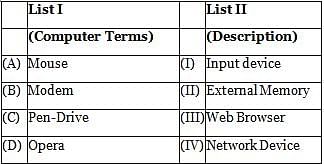
Choose the correct answer from the options given below:
Which of the following is not a type of LAN technology?
Which of the following is not a source of pollution in soil?
TEQIP (Technical Education Quality Improvement Programme) was launched by MHRD in which of the following years?
Directions: Read the following passage carefully and answer the following question.
All historians are interpreters of text if they be private letters, Government records or parish birthlists or whatever. For most kinds of historians, these are only the necessary means to understanding something other than the texts themselves, such as a political action or a historical trend, whereas for the intellectual historian, a full understanding of his chosen texts is itself the aim of his enquiries. Of course, the intellectual history is particularly prone to draw on the focus of other disciplines that are habitually interpreting texts for purposes of their own, probing the reasoning that ostensibly connects premises and conclusions. Furthermore, the boundaries with adjacent subdisciplines are shifting and indistinct, the history of art and science both claim a certain autonomy, partly just because they require specialised technical skills. Both can also be seen as part of a wider intellectual history, as is evident when one considers. For example, the common stock of knowledge about cosmological beliefs or moral ideals of a period.
Like all historians, the intellectual historian is a consumer rather than a producer of ‘methods’. His distinctiveness lies in which aspect of the past he is trying to illuminate, not in having exclusive possession of either a corpus of evidence or a body of techniques. That being said, it does seem that the label ‘intellectual history’ attracts a disproportionate share of misunderstanding.
It is alleged that intellectual history is the history of something that never really mattered. The long dominance of the historical profession by political historians bred a kind of philistinism, an unspoken belief that power and its exercise was ‘what mattered’. The prejudice was reinforced by the assertion that political action was never really the outcome of principles or ideas that were ‘more flapdoodle’. The legacy of this precept is still discernible in the tendency to require ideas to have ‘licensed’ the political class before they can be deemed worthy of intellectual attention, as if there were some reasons why the history of art or science, of philosophy or literature, were somehow of interest and significance than the history of Parties or Parliaments. Perhaps in recent years, the mirror-image of this philistinism has been more common in the claim that ideas of any one systematic expression or sophistication do not matter, as if they were only held by a minority.
Q. Intellectual historians do not claim exclusive possession of
Which one of the following is a non-probability sampling?
Directions: Read the data given in the following bar-graph carefully and answer the following question.
The bar-graph shows the net profit of a multinational company ABC (in Cr) from 2001-2002 to 2008-2009.
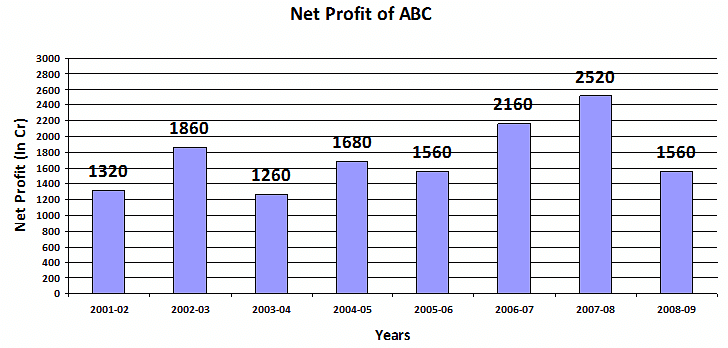
Q. If the company had predicted the net profit for the year 2003-04 after interpolating (linear) the profit from 2001-02 to 2002-03, what was their prediction?
The population information is called parameter while the corresponding sample information is known as
|
60 tests
|




